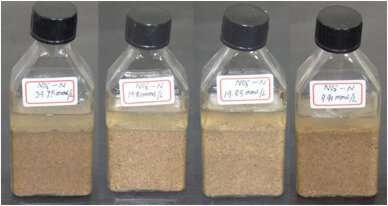Microbial material modification helps to control frost heave and saline soil solidification

Chinese researchers recently conducted a study on process of biogas generation improving physical and mechanical properties of soil.
A research team led by Sheng Yu from the Northwest Institute of Eco-Environmental Resources (NIEER) of the Chinese Academy of Sciences (CAS), together with their colleagues from Southeast University, has implanted Pseudomonas Stutzeri in the soil pores and induced it to produce nitrogen bubbles, and they also analyzed the influence mechanism of mitigation of sand liquefaction using biogas bubbles.
In the natural environment, there are many microorganisms in rock and soil masses, and its metabolic activities will change physical and mechanical properties of rock and soil. These microbial activities can be controlled, enhanced and used to solve geotechnical problems, and such methods have been named as biogeotechnologies. As an emerging interdisciplinary field, it has developed rapidly in recent years due to its advantages of low carbon and friendly environment.
From the perspective of practical application, biogeotechnologies can be used for rock and soil reinforcement, sealing of water leakage, prevention of sand liquefaction, soil erosion resistance control, and contaminated soil treatment and so on.
Based on the above research results, the NIEER research group is exploring to apply biogeotechnologies to frost heave control and saline soil solidification, and has achieved some preliminary results.
In this study, the researchers applied biogas generation process to soil frost heaving treatment, and studied improvement of biogas production performance under low temperature conditions.
Results showed that sealing effect of bubbles and microorganisms on the water migration path can reduce soil permeability coefficient by one order of magnitude.
Besides, they also introduced biomineralization to solve the prominent problem of saline soil with high chloride content in Northwestern China.
Based on excellent curing effect, they analyzed the deterioration mechanism of chloride salt on the mineralization process using micro method. The strength of solidified soil can reach 2.9 to 4.5 MPa.
This research can provide scientific basis and theoretical support for application of microbial materials in geotechnical engineering and development of green construction technology.
These studies have been published in Journal of Environmental Management and Journal of Cleaner Production, respectively.
More information: Erxing Peng et al, Mitigation of sand liquefaction under static loading condition using biogas bubbles generated by denitrifying bacteria, Journal of Environmental Management (2021). DOI: 10.1016/j.jenvman.2021.113106
Erxing Peng et al, Anti-liquefaction performance of partially saturated sand induced by biogas under high intensity vibration, Journal of Cleaner Production (2021). DOI: 10.1016/j.jclepro.2021.128794
Journal information: Journal of Environmental Management , Journal of Cleaner Production
Provided by Chinese Academy of Sciences





















